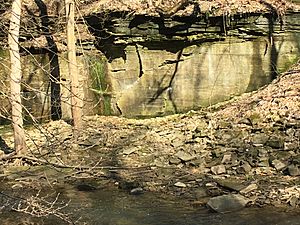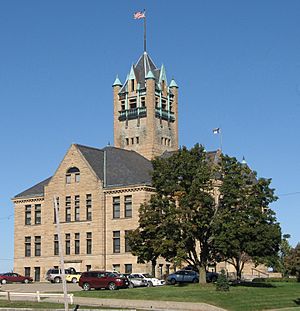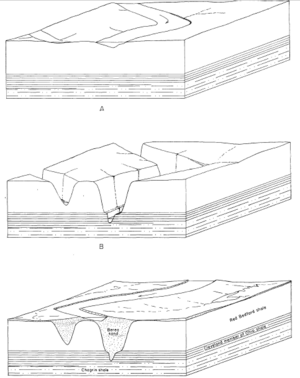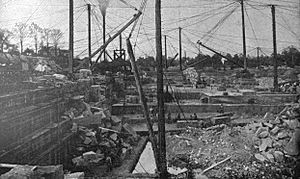Berea Sandstone facts for kids
Quick facts for kids Berea SandstoneStratigraphic range: Late Devonian |
|
|---|---|

Berea Sandstone exposed at headwaters of the Sandusky River, Crawford County, Ohio.
|
|
| Type | Formation |
| Unit of | Waverly Group |
| Underlies | Sunbury Shale |
| Overlies | Bedford Shale and Ohio Shale |
| Lithology | |
| Primary | sandstone, siltstone |
| Location | |
| Region | Michigan, Ohio, Pennsylvania, West Virginia, Kentucky |
| Country | United States |
| Type section | |
| Named for | Berea, Ohio |
The Berea Sandstone, also known as Berea Grit, is a type of sandstone rock found in the United States. You can find it in states like Michigan, Ohio, Pennsylvania, West Virginia, and Kentucky. It gets its name from Berea, Ohio, where a lot of it was found. This sandstone has been used for building many structures. It is also an important source of oil and natural gas.
Contents
What is Berea Sandstone?
Berea Sandstone is a rock layer found in two main areas. One area is the Appalachian Basin, covering parts of Ohio, Pennsylvania, West Virginia, and Kentucky. The other is the Michigan Basin, mostly in eastern Michigan. These two rock areas are separate from each other.
This sandstone usually sits above the Bedford Shale and the Ohio Shale. It is found below the Sunbury Shale. Berea Sandstone is light gray to a yellowish-brown color. It can be made of fine sand or even finer silt. Sometimes it looks very similar to the Bedford Shale below it. Geologists group Berea Sandstone as part of the Waverly Group. This means it belongs to a larger family of rock layers. The Berea Sandstone can be very thick. In some places, it is as thick as a 20-story building!
A geologist named J. S. Newberry first named it "Berea Grit" in 1874. He chose the name after Berea, Ohio. This town was famous for its many quarries where this stone was dug up.
How Old is Berea Sandstone?
Berea Sandstone formed a very long time ago. It was created during the Late Devonian period. This period ended about 359 million years ago. The sand that made up the Berea Sandstone came from the north. It traveled in a large river from high lands in eastern Canada. This sand was then dropped off in a river delta. A delta is where a river spreads out and deposits sediment as it enters a larger body of water.
Scientists believe the river first flowed into the Ohio area. Later, it might have changed course and flowed into the Michigan area. This would mean the Michigan Berea Sandstone is a bit younger. Over millions of years, the land changed. This caused the two main areas of Berea Sandstone to become disconnected.
Fossils in the Stone
Generally, Berea Sandstone does not contain many fossils. However, some interesting finds have been made. Scientists have found fossils of fish, including types called Ctenacanthus and Gonatodus. Plant fossils from the genus Annularia have also been discovered. You might also find some brachiopods, which are small sea creatures with two shells.
What is Berea Sandstone Used For?

Berea Sandstone has been used for many different purposes. It is a popular choice for building. For example, the Johnson County Courthouse in Iowa is made from this stone. The Brown County Courthouse in South Dakota also uses it. Even parts of the Centre Block building of the Parliament of Canada use Berea Sandstone. It is used there for window and door frames.
Besides buildings, Berea Sandstone is also used as flagstone. Flagstone is flat stone used for paths or patios. It has also been used for paving roads. Very fine-grained Berea Sandstone is special. It has been used to make grindstones and whetstones. These tools help sharpen knives and other blades.
Berea Sandstone Industry
Digging for Stone (Quarrying)
People started digging up Berea Sandstone in 1830. At first, they mostly made grindstones. But by the 1840s, they began to use it for building stones and flagstones too. Many different companies used to dig for this sandstone. However, by 1893, most of them joined together. They formed a big company called the Cleveland Stone Company. This company became the largest sandstone producer in the United States.
Oil and Natural Gas
Berea Sandstone is important because it holds oil and natural gas. People started drilling for gas in this sandstone around 1859 in East Liverpool, Ohio. Oil was found in the Berea Sandstone in 1860 in Mecca Township, Ohio.
In Michigan, oil was first found in Berea Sandstone in 1925 in Saginaw. This oil field was the only source of oil in Michigan until 1927. By 2011, the Berea Sandstone in northeastern Kentucky was producing the most oil in that state.
Images for kids







